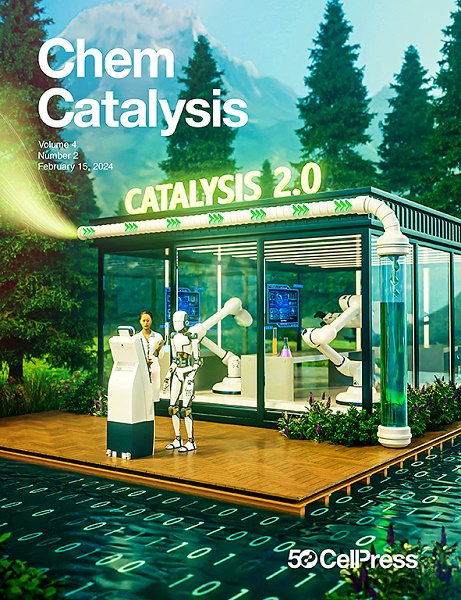Cooperative effects associated with high electrolyte concentrations in driving the conversion of CO2 to C2H4 on copper
IF 11.6
Q1 CHEMISTRY, PHYSICAL
引用次数: 0
Abstract
Compared to a conventional electrolyte concentration of 1 M HCOOK, the use of a highly concentrated 7.1 M HCOOK electrolyte increases the Faradaic efficiency (FE) ratio of C2H4/CO from 2.2 ± 0.3 to 18.3 ± 4.8 at −1.08 V vs. reversible hydrogen electrode (RHE) on a Cu gas-diffusion electrode. Based on electrochemical analysis and ab initio molecular dynamics (AIMD) simulation, the identity and concentration of the cation and anion play more important roles in controlling the CO2R reaction pathway than the bulk CO2 solubility and the bulk pH of electrolytes. In situ attenuated reflectance surface enhanced infrared absorption spectroscopy (ATR-SEIRAS) suggests that, unlike 1 M HCOOK, the ∗CO-bridge-binding mode on Cu is dominant in 7.1 M HCOOK electrolyte, which potentially results in less CO release and higher yield of C2H4. This study demonstrates that although we can tailor the electrolyte composition to shift product selectivity, the factors that control the product selectivity are numerous and cannot be distilled down into one correlated property-reactivity relationship.

高浓度电解质在推动铜上 CO2 向 C2H4 转化过程中的协同效应
与传统的 1 M HCOOK 电解质浓度相比,使用高浓度 7.1 M HCOOK 电解质可将铜气体扩散电极上的 C2H4/CO 在 -1.08 V 下的法拉第效率(FE)比从 2.2 ± 0.3 提高到 18.3 ± 4.8。根据电化学分析和原子分子动力学模拟(AIMD),阳离子和阴离子的特性和浓度在控制 CO2R 反应途径方面的作用比二氧化碳的溶解度和电解质的 pH 值更为重要。原位衰减反射表面增强红外吸收光谱(ATR-SEIRAS)表明,与 1 M HCOOK 不同,在 7.1 M HCOOK 电解质中,Cu 上的∗CO 桥结合模式占主导地位,这可能导致较少的 CO 释放和较高的 C2H4 产量。这项研究表明,虽然我们可以通过调整电解质成分来改变产物选择性,但控制产物选择性的因素很多,无法归结为一种相关的性质-反应关系。
本文章由计算机程序翻译,如有差异,请以英文原文为准。
求助全文
约1分钟内获得全文
求助全文
来源期刊
CiteScore
10.50
自引率
6.40%
发文量
0
期刊介绍:
Chem Catalysis is a monthly journal that publishes innovative research on fundamental and applied catalysis, providing a platform for researchers across chemistry, chemical engineering, and related fields. It serves as a premier resource for scientists and engineers in academia and industry, covering heterogeneous, homogeneous, and biocatalysis. Emphasizing transformative methods and technologies, the journal aims to advance understanding, introduce novel catalysts, and connect fundamental insights to real-world applications for societal benefit.

 求助内容:
求助内容: 应助结果提醒方式:
应助结果提醒方式:


